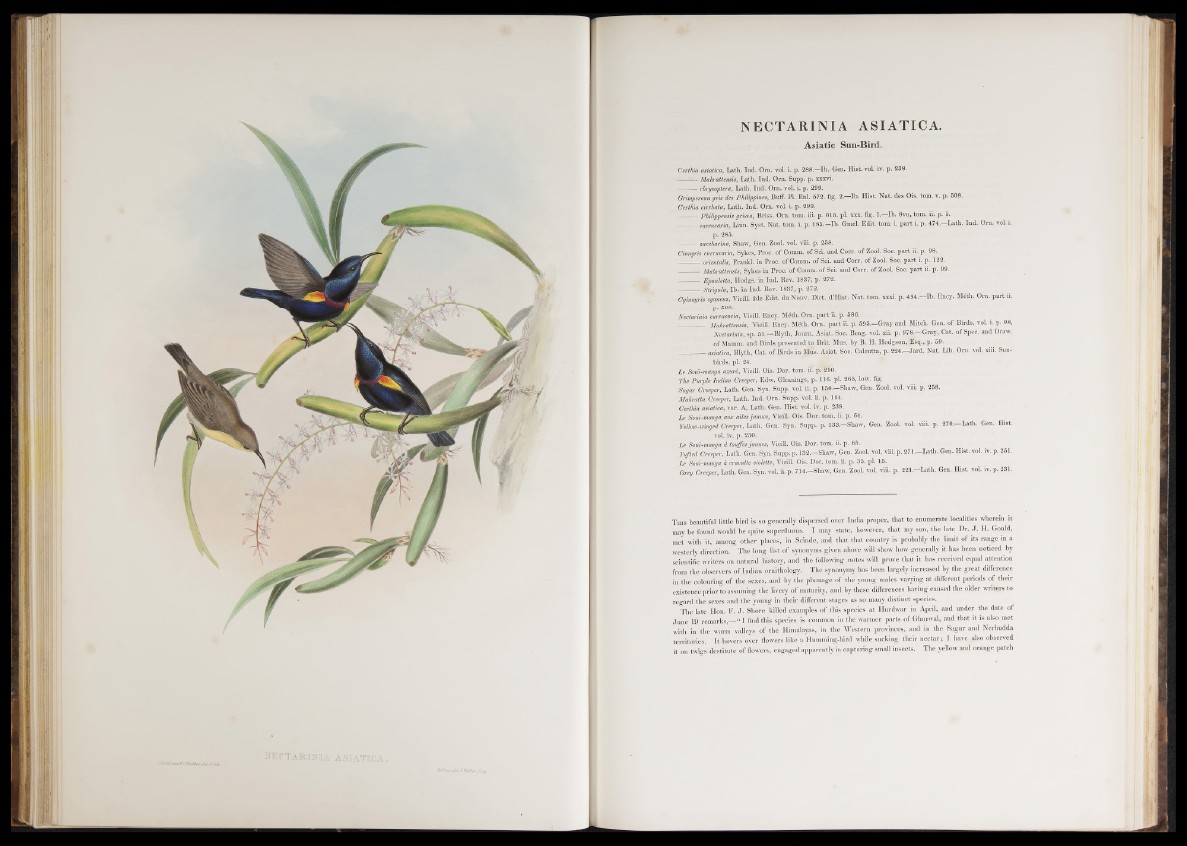
N E C T A R I N I A A S I A T I C A .
Asiatic Sun-Bird.
Certhia asiatica, Lath. Ind. Om. vol. i. p. 288.—Ib. Gen. Hist. vol. iv. p. 238.
Mahrattensis, Lath. Ind. Orn. Supp. p. xxxvi.
—:— chrysoptera, Lath. Ind. Om. vol. i; p. 299.
Grimpereau gris des Philippines, Buff. PI. Enl. 572. fig. 2.—Ib. Hist. Nat. des Ois. tom. v. p. 508.
Certhia cirrhata, Lath. Ind. Om. vol. i. p. 299.
Philippensis grisea, Briss. Om. tom. iii. p. 615. pi. xxx. fig. 1.—Ib. 8vo, tom. ii. p. 5.
currucaria, Linn. Syst. Nat. tom. i. p. 185.—Ib. Gmel. Edit. tom. i. part i. p. 474.—Lath. Ind. Om. vol.i.
p. 285.
saccharina, Shaw, Gen. Zool. vol. viii. p. 258.
Cimyris currucaria, Sykes, Proc. of Comm, of Sci. and Corr. of Zool. Soc. part ii. p. 98.
______ orierttalis, Frankl. in Proe. of Comm, of Sci. and Corr. of Zool. Soc. p art i. p. 122.
Mahrattensis, Sykes in Proc. of Comm, of Sci. and Corr. of Zool. Soc. part ii. p. 99.
----— Epauletta, Hodgs. in Ind. Rev. 1837, p. 272.
---------- Strigula, Ib. in Ind. Rev. 1837, p. 272.
Cyimyris cyaneus, Vieill. 2de Edit, du Nouv. Diet, d’Hist. Nat. tom. xxxi. p. 494.—Ib. Ency. Meth. Orn. part ii.
p. 598.
Nectarinia currucaria, Vieill. EnCy. M e th . Orn. p artii. p. 586.
Mahrattensis,. Vie ill. Ency.. M e th . Om. part ii. p. 595.—Gray and Mitch. Gen. of Birds, vol. i. p. 98,
Nectarinia, s p .5 1 .— B ly th , Joum. Asiat. Soc. Beng. vol. xii. p. 978.—Gray, Cat. of Spec, and Draw,
of Mamm. and Birds presented to Brit. Mus. by B. H. Hodgson, Esq., p. 59.
asiatica, Blyth, Cat. of Birds in Mus. Asiat. Soc. Calcutta, p. 224.—Jard. Nat. Lib. Om. vol. xiii. Sunbirds,
pi. 24.
Le Soui-manga azwrS, Vieill. Ois. Dor. tom. ii. pi-^10.
The Purple Indian Creeper, Edw. Gleanings, p. 116. pi. 265, low. fig.
Sugar Creeper, Lath. Gen. Syn. Supp. vol. ii. p. 150.—Shaw, Gen. Zool. vol. viii. p. 258.
Mahratta Creeper, Lath. Ind. Om. Supp. vol. ii. p. 164.
Certhia asiatica, var. A, Lath. Gen. Hist. vol. iv. p. 238.
Le Soui-manga am ailes jdunes, Vieill. Ois. Dor. tom, ii. p. 64.
Yellow-winged Creeper, Lath. Gen. Syn. Supp. p. 133.—Shaw, Gen. Zool. vol. viii. p. 270ir-r-Lath. Gen. Hist,
vol. iv. p., 250.'
Le Soui-manga ct touffes jaunes, Vieill. Ois. Dor. tom. ii. p. 65.
Tufted Creeper, Lath. Gen. Syn. Supp. p. 132.—Shaw, Gen. Zool. vol. viii. p. 271.—Lath. Gen. Hist. vol. iv. p. 251.
Le Soui-manga & cravatte violette, Vieill. Ois. Dor. tom. ii. p. 35. pi. 16.
Grey Creeper, Lath. Gen. Syn. vol. ii. p. 714.—Shaw, Gen. Zool. vol. viii. p. 221.—Lath. Gen. Hist. vol. iv. p, 231.
T his beautiful little bird is so generally dispersed over India proper, that to enumerate localities wherein it
may be found would be quite superfluous. I may state, however, that my son, the late Dr. J . H. Gould,
met with it, among other places, in Scinde, and that that country is probably the limit o f its range in a
westerly direction. The long list of synonyms given above will show how generally it has been noticed by
scientific writers on natural history, and the following notes will prove that it has received equal attention
from the observers of Indian ornithology. The synonymy has been largely increased by the great difference
in the colouring of the sexes, and by the plumage of the young males varying a t different periods of their
existence prior to assuming the livery o f maturity, and by these differences having caused the older writers to
regard the sexes and the young in their different stages as so many distinct species.
The late Hon. F. J . Shore killed examples of this species a t Hurdwar in April, and under the date of
June 19 remarks,—“ I find this species is common in the warmer parts of Ghurwal, and that it is also met
with in the warm valleys of the Himalayas, in the Western provinces, and in the Sagur and Nerbudda
territories. It hovers over flowers like a Humming-bird while sucking their n e c ta r; I have also observed
it on twigs destitute of flowers, engaged apparently in capturing small insects. The yellow and orange patch